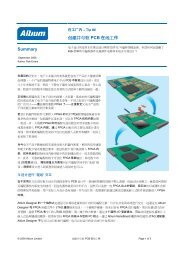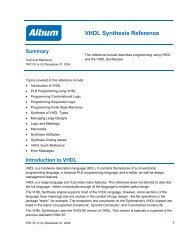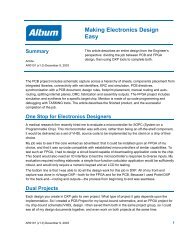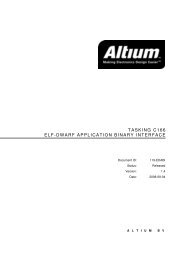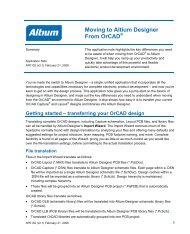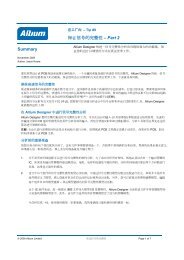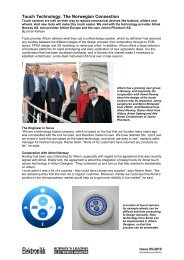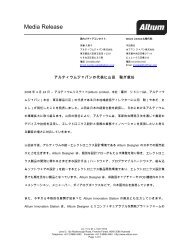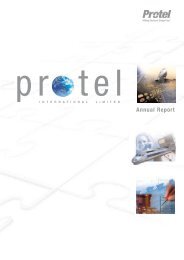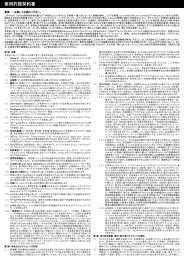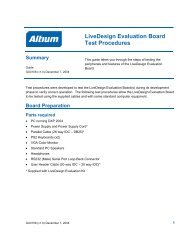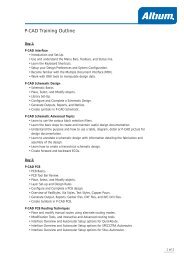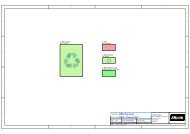Printable Version - Altium
Printable Version - Altium
Printable Version - Altium
You also want an ePaper? Increase the reach of your titles
YUMPU automatically turns print PDFs into web optimized ePapers that Google loves.
<strong>Altium</strong> enabling next-generation electronics design<br />
<strong>Altium</strong> has completely<br />
changed the way we<br />
design our electronics.<br />
The integrated database<br />
libraries have streamlined<br />
our designs, allowing our<br />
engineers to just drag<br />
and drop components,<br />
pre-approved schematic<br />
symbols and footprints<br />
straight onto the<br />
schematic. The regular<br />
updates are also great.<br />
The new MCAD ECAD<br />
real-time collaboration<br />
technology means we<br />
can fit our boards first<br />
time, every time.<br />
Scott Gemmell<br />
Engineering Manager,<br />
Leica Geosystems Agriculture<br />
For more information visit www.altium.com<br />
Leica Geosystems – Agriculture<br />
This is about an outsourced design gone wrong, a new product launch and how it<br />
changed the way Leica Geosystems Agriculture completes its electronic designs.<br />
You’ve heard the disaster stories and the tales of<br />
those who have fallen before you, except you never<br />
thought that it would ever happen to you. But then<br />
one day it does: and there you are, staring at a mess<br />
of a PCB wondering, “what was the contractor<br />
thinking?”<br />
The story may seem familiar enough, but for<br />
Leica Geosystems this was no lunchtime gossip.<br />
During the development of the Leica mojoRTK (an<br />
auto-steer guidance system for precision farming<br />
applications) the company outsourced one of<br />
its boards to a contractor. It was a decision the<br />
company soon regretted. The board was returned<br />
behind schedule and failed to meet any of its<br />
design and manufacturing requirements. Left with<br />
a defunct PCB and a looming product launch, Leica<br />
Geosystems had to ask itself one question: risk<br />
going back to the contractor, or overhaul the design<br />
and complete it in-house?<br />
Challenge or unexpected<br />
opportunity?<br />
It didn’t take long for Scott Gemmell, Engineering<br />
Manager at Leica Geosystems Agriculture to make<br />
up his mind. The motto at Leica Geosystems is<br />
“when it has to be right,” so it was clear to Scott<br />
that this design had to be completed in-house.<br />
However, the process was not going to be easy. The<br />
engineers needed to recapture the board design,<br />
translate files, and carefully recreate the PCB.<br />
Scott remembers the project clearly:<br />
“It was a major challenge. The product was at a<br />
pre-production stage, but it was in no condition to<br />
be manufactured. We had to recapture the entire<br />
design and completely rearrange it so it could be<br />
reliably manufactured and sent to market. This was<br />
our flagship product, so it had to be right.”<br />
However, challenges sometimes offer unexpected<br />
opportunities. Scott’s team had recently upgraded<br />
to <strong>Altium</strong> Designer and was starting to make the<br />
most of its latest features – features that completely<br />
changed the team’s design methodology.<br />
The biggest change: integrated database libraries.<br />
These allowed Scott and his team of engineers to<br />
link directly to inventory and components stored<br />
in their external databases. Using this feature,<br />
engineers could choose and place components from<br />
various databases, while creating a library specific<br />
to the project. They could also easily update and<br />
manage these databases from within their own<br />
design space.<br />
“We can just drag and drop components, preapproved<br />
schematic symbols and footprints straight<br />
onto the schematic. Using this feature and others in<br />
<strong>Altium</strong> Designer, we were able to review our design<br />
processes, change our philosophy and develop a<br />
much more lean development strategy,” comments<br />
Scott.<br />
Integrated libraries also helped Scott and his team<br />
to source and cost components. “We have heavy<br />
production cycles, so we use integrated libraries to<br />
cost our products and reduce our product turnaround<br />
time.”<br />
It was time to stop guessing and<br />
close that revision loop<br />
During product development, the design team<br />
would often suffer through a number of iterations<br />
as the PCB and product enclosures were brought<br />
together. The typically sequential process consisted<br />
of several clumsy, time consuming revisions. But<br />
with <strong>Altium</strong>’s new MCAD-ECAD collaboration<br />
technology, Scott and his team could reduce these<br />
revisions. The team could finally work more closely<br />
with its industrial design team by using <strong>Altium</strong>’s<br />
IGES format and STEP format files import-export<br />
function. This opened up new data sharing capabilities<br />
and allowed the electronics and mechanical<br />
teams to collaborate on the final design.<br />
This, alongside <strong>Altium</strong>’s 3D visualization engine,<br />
helped build confidence around the design of the<br />
Leica mojoRTK. Scott has seen a big difference in<br />
his team’s prototypes and says that the feature allows<br />
them to accurately visualize the PCB in its final<br />
form.<br />
“The 3D interface is really speeding up the development<br />
phase and increasing our confidence in our<br />
prototypes. It just gives us that final assurance<br />
before we commit to any serious money.”
<strong>Altium</strong> enabling next-generation electronics design<br />
The only constant is change<br />
Using these <strong>Altium</strong> features, Leica Geosystems<br />
completed the mojoRTK product and released it<br />
to the market in January 2008. The product has<br />
gone on to be implemented across the agriculture<br />
industry.<br />
However, as with any successful product launch,<br />
there will always be opportunities to update the<br />
product or expand the product range. For example,<br />
Scott’s team is currently moving multiple PCBs to a<br />
flatter, more economic design to capitalize on new<br />
market opportunities.<br />
“We are moving multiple PCBs across onto a<br />
flat design. We’ve been able to generate a quick<br />
design by using <strong>Altium</strong>’s signal harness feature,”<br />
comments Scott.<br />
Scott and his team also use <strong>Altium</strong>’s new 3D<br />
MCAD-ECAD real-time dynamic clearance checking<br />
between the mechanical design and the PCB. And<br />
coupled with <strong>Altium</strong>’s unified design environment,<br />
Scott and his team can make changes on the spot<br />
knowing that they will be reflected throughout the<br />
schematic and board designs.<br />
“It used to take several revisions before we could<br />
finalise electronics and their mechanicals – now we<br />
only have one design cycle, and it fits perfectly.”<br />
This is just one example of the design<br />
improvements experienced by Scott’s team.<br />
About <strong>Altium</strong><br />
Remaining up-to-date with the latest <strong>Altium</strong><br />
technology has also improved efficiency and overall<br />
performance for the team.<br />
“Since staying ahead of the changes<br />
in technology and using the latest<br />
features in <strong>Altium</strong> Designer, we’ve<br />
seen productivity and output increase<br />
by 25%. <strong>Altium</strong>’s regular updates<br />
have also made significant design<br />
improvements. The team has found the<br />
features easy to learn and adopt, and<br />
we are eager to see more.”<br />
About Leica Geosystems –<br />
Agriculture<br />
When it has to be right – Leica Geosystems.<br />
For more information about the Leica mojoRTK<br />
auto-steer platform, or Leica Geosystems<br />
agriculture solutions, visit www.mojoRTK.com<br />
<strong>Altium</strong>’s solutions<br />
implemented in the<br />
precision agriculture<br />
industry<br />
<strong>Altium</strong> Limited (ASX:ALU) provides world-leading unified design solutions that break<br />
down the barriers to innovation, and help organisations easily harness the latest devices<br />
and technologies, to create their next generation of electronic products.<br />
<strong>Altium</strong>’s solutions are unique because they unify the separate processes of electronics<br />
design, all within a single electronics design environment, working off a single data<br />
model, which links all the aspects of electronics product design into one process.<br />
Founded in 1985, <strong>Altium</strong> has headquarters in Sydney, Australia, sales offices in the<br />
United States, Europe, Japan, China, and resellers in all other major markets. For more<br />
information, please visit www.altium.com<br />
Copyright © 2008 <strong>Altium</strong> Limited. All Rights Reserved. <strong>Altium</strong>, <strong>Altium</strong> Designer, Board Insight, DXP, Innovation Station, LiveDesign,<br />
NanoBoard, NanoTalk, OpenBus, P-CAD, SimCode, Situs, TASKING, and Topological Autorouting and their respective logos are trademarks<br />
or registered trademarks of <strong>Altium</strong> Limited or its subsidiaries. All other registered or unregistered trademarks referenced herein are the<br />
property of their respective owners and no trademark rights to the same are claimed. 4381



